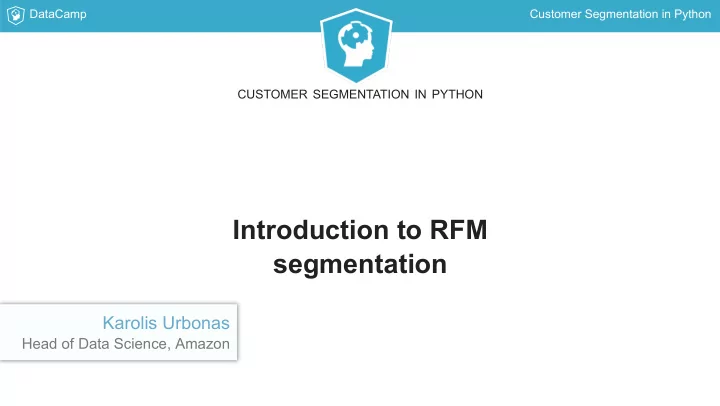

DataCamp Customer Segmentation in Python CUSTOMER SEGMENTATION IN PYTHON Introduction to RFM segmentation Karolis Urbonas Head of Data Science, Amazon
DataCamp Customer Segmentation in Python What is RFM segmentation? Behavioral customer segmentation based on three metrics: Recency (R) Frequency (F) Monetary Value (M)
DataCamp Customer Segmentation in Python Grouping RFM values The RFM values can be grouped in several ways: Percentiles e.g. quantiles Pareto 80/20 cut Custom - based on business knowledge We are going to implement percentile-based grouping.
DataCamp Customer Segmentation in Python Short review of percentiles Process of calculating percentiles: 1. Sort customers based on that metric 2. Break customers into a pre-defined number of groups of equal size 3. Assign a label to each group
DataCamp Customer Segmentation in Python Calculate percentiles with Python Data with eight CustomerID and a randomly calculated Spend values.
DataCamp Customer Segmentation in Python Calculate percentiles with Python spend_quartiles = pd.qcut(data['Spend'], q=4, labels=range(1,5)) data['Spend_Quartile'] = spend_quartiles data.sort_values('Spend')
DataCamp Customer Segmentation in Python Assigning labels Highest score to the best metric - best is not always highest e.g. recency In this case, the label is inverse - the more recent the customer, the better
DataCamp Customer Segmentation in Python Assigning labels # Create numbered labels r_labels = list(range(4, 0, -1)) # Divide into groups based on quartiles recency_quartiles = pd.qcut(data['Recency_Days'], q=4, labels=r_labels) # Create new column data['Recency_Quartile'] = recency_quartiles # Sort recency values from lowest to highest data.sort_values('Recency_Days')
DataCamp Customer Segmentation in Python Assigning labels As you can see, the quartile labels are reversed, since the more recent customers are more valuable.
DataCamp Customer Segmentation in Python Custom labels We can define a list with string or any other values, depending on the use case. # Create string labels r_labels = ['Active', 'Lapsed', 'Inactive', 'Churned'] # Divide into groups based on quartiles recency_quartiles = pd.qcut(data['Recency_Days'], q=4, labels=r_labels) # Create new column data['Recency_Quartile'] = recency_quartiles # Sort values from lowest to highest data.sort_values('Recency_Days')
DataCamp Customer Segmentation in Python Custom labels Custom labels assigned to each quartile
DataCamp Customer Segmentation in Python CUSTOMER SEGMENTATION IN PYTHON Let's practice with percentiles!
DataCamp Customer Segmentation in Python CUSTOMER SEGMENTATION IN PYTHON Recency, Frequency, Monetary Value calculation Karolis Urbonas Head of Data Science, Amazon
DataCamp Customer Segmentation in Python Definitions Recency - days since last customer transaction Frequency - number of transactions in the last 12 months Monetary Value - total spend in the last 12 months
DataCamp Customer Segmentation in Python Dataset and preparations Same online dataset like in the previous lessons Need to do some data preparation New TotalSum column = Quantity x UnitPrice .
DataCamp Customer Segmentation in Python Data preparation steps We're starting with a pre-processed online DataFrame with only the latest 12 months of data: print('Min:{}; Max:{}'.format(min(online.InvoiceDate), max(online.InvoiceDate))) Min:2010-12-10; Max:2011-12-09 Let's create a hypothetical snapshot_day data as if we're doing analysis recently. snapshot_date = max(online.InvoiceDate) + datetime.timedelta(days=1)
DataCamp Customer Segmentation in Python Calculate RFM metrics # Aggregate data on a customer level datamart = online.groupby(['CustomerID']).agg({ 'InvoiceDate': lambda x: (snapshot_date - x.max()).days, 'InvoiceNo': 'count', 'TotalSum': 'sum'}) # Rename columns for easier interpretation datamart.rename(columns = {'InvoiceDate': 'Recency', 'InvoiceNo': 'Frequency', 'TotalSum': 'MonetaryValue'}, inplace=True) # Check the first rows datamart.head()
DataCamp Customer Segmentation in Python Final RFM values Our table for RFM segmentation is completed!
DataCamp Customer Segmentation in Python CUSTOMER SEGMENTATION IN PYTHON Let's practice calculating RFM values!
DataCamp Customer Segmentation in Python CUSTOMER SEGMENTATION IN PYTHON Building RFM segments Karolis Urbonas Head of Data Science, Amazon
DataCamp Customer Segmentation in Python Data Dataset we created previously Will calculate quartile value for each column and name then R , F , M
DataCamp Customer Segmentation in Python Recency quartile r_labels = range(4, 0, -1) r_quartiles = pd.qcut(datamart['Recency'], 4, labels = r_labels) datamart = datamart.assign(R = r_quartiles.values)
DataCamp Customer Segmentation in Python Frequency and Monetary quartiles f_labels = range(1,5) m_labels = range(1,5) f_quartiles = pd.qcut(datamart['Frequency'], 4, labels = f_labels) m_quartiles = pd.qcut(datamart['MonetaryValue'], 4, labels = m_labels) datamart = datamart.assign(F = f_quartiles.values) datamart = datamart.assign(M = m_quartiles.values)
DataCamp Customer Segmentation in Python Build RFM Segment and RFM Score Concatenate RFM quartile values to RFM_Segment Sum RFM quartiles values to RFM_Score def join_rfm(x): return str(x['R']) + str(x['F']) + str(x['M']) datamart['RFM_Segment'] = datamart.apply(join_rfm, axis=1) datamart['RFM_Score'] = datamart[['R','F','M']].sum(axis=1)
DataCamp Customer Segmentation in Python Final result
DataCamp Customer Segmentation in Python CUSTOMER SEGMENTATION IN PYTHON Let's practice building RFM segments
DataCamp Customer Segmentation in Python CUSTOMER SEGMENTATION IN PYTHON Analyzing RFM segments Karolis Urbonas Head of Data Science, Amazon
DataCamp Customer Segmentation in Python Largest RFM segments datamart.groupby('RFM_Segment').size().sort_values(ascending=False)[:10]
DataCamp Customer Segmentation in Python Filtering on RFM segments Select bottom RFM segment "111" and view top 5 rows datamart[datamart['RFM_Segment']=='111'][:5]
DataCamp Customer Segmentation in Python Summary metrics per RFM Score datamart.groupby('RFM_Score').agg({ 'Recency': 'mean', 'Frequency': 'mean', 'MonetaryValue': ['mean', 'count'] }).round(1)
DataCamp Customer Segmentation in Python Grouping into named segments Use RFM score to group customers into Gold , Silver and Bronze segments. def segment_me(df): if df['RFM_Score'] >= 9: return 'Gold' elif (df['RFM_Score'] >= 5) and (df['RFM_Score'] < 9): return 'Silver' else: return 'Bronze' datamart['General_Segment'] = datamart.apply(segment_me, axis=1) datamart.groupby('General_Segment').agg({ 'Recency': 'mean', 'Frequency': 'mean', 'MonetaryValue': ['mean', 'count'] }).round(1)
DataCamp Customer Segmentation in Python New segments and their values
DataCamp Customer Segmentation in Python CUSTOMER SEGMENTATION IN PYTHON Practice building custom segments
Recommend
More recommend